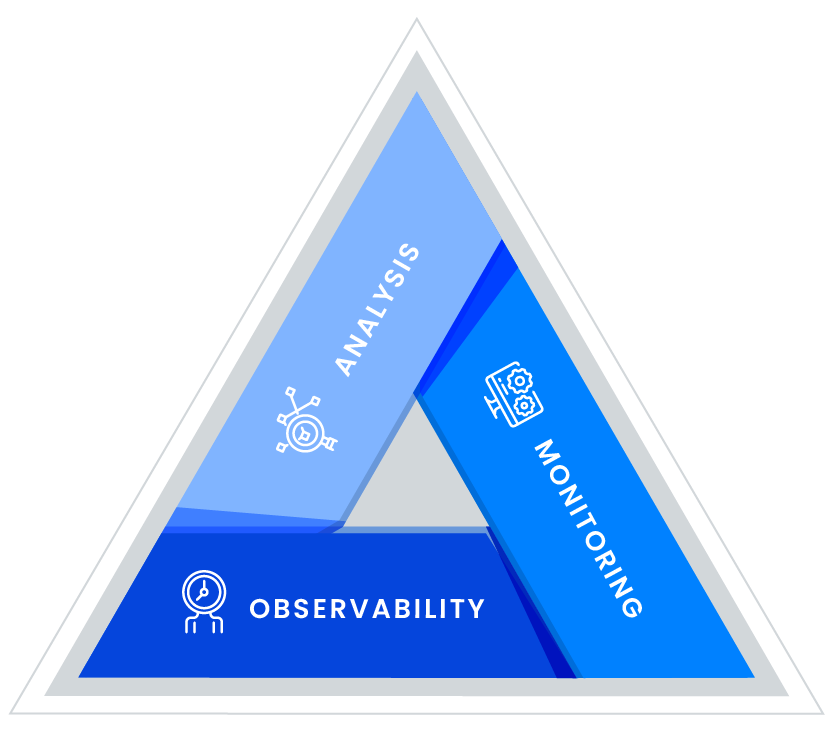
Prashant Sakharkar
Essential Role of Observability and Monitoring in DevOps: Tools, Challenges and Best Practices
In the rapidly evolving world of software development, DevOps has become critical for companies to deliver high-quality products quickly. With DevOps, improvement in quality, cost management, faster development and regular testing are the most obvious expectations. Central to this are observability and monitoring tools in DevOps that offer automation and wider visibility throughout the development lifecycle – from development, planning, integration and testing to deployment and operations.
Importance of Observability and Monitoring in DevOps
DevOps is more than a methodology—it’s a cultural shift that enhances collaboration among cross-functional teams. Monitoring and observability are at the heart of this, acting as critical DevOps tools that provide a deep understanding of the systems in play.
Proactive Issue Resolution: This approach helps detect anomalies early before they cause real problems. For example, by monitoring CPU usage and memory leaks, teams can address issues before they impact user experience or lead to costly downtime.
Boosted Collaboration: By sharing data from DevOps monitoring tools, teams can easily align on system health and performance levels. This transparency helps to remove barriers between roles, leading to more efficient problem-solving and innovation.
Continuous Enhancement: Monitoring systems collect vast amounts of data over time, which can be analyzed to discover trends and patterns. These insights allow teams to continuously refine and optimize their processes, improving efficiency and performance.
DevOps Monitoring Tools
Deploying effective monitoring and observability in DevOps practices involves a variety of tools and strategies:
Centralized Logging: Centralized logging systems like ELK Stack or Splunk help gather all logs in one place, making it easier for team members to find and diagnose issues quickly. This not only speeds up troubleshooting but also improves system transparency.
Metrics and Alerting: DevOps monitoring tools such as Prometheus for metrics collection and Grafana for dashboard creation help teams monitor systems in real-time. For instance, setting up alerts for high error rates or slow response times ensures that potential issues can be handled immediately.
Distributed Tracing: Understanding how requests travel through microservices is crucial in complex systems. Tools like Jaeger provide tracing capabilities that allow teams to see where bottlenecks or failures occur, helping to swiftly resolve issues and optimize data flow.
Synthetic Monitoring: Synthetic monitoring tools like Selenium automate application interactions to test and monitor performance consistently. This can simulate typical user paths through the application, identifying slowdowns or errors before they affect a real user.
Challenges of Monitoring and Observability
Despite their benefits, monitoring and observability can introduce several challenges that may undermine their effectiveness. The key pain points of observability and monitoring in DevOps are:
- Data Overload: The volume of data can be overwhelming, making it difficult to filter relevant information and potentially raising storage costs.
- Complexity and Skill Gaps: As systems and tools become more complex, they can be challenging to integrate and require specialized knowledge, creating skill gaps within teams.
- Alert Fatigue and Noise: Frequent false alarms can cause alert fatigue, which can lead to overlooked critical alerts, reducing the overall effectiveness of monitoring efforts.
- Security and Compliance Risks: DevOps monitoring tools that handle vast amounts of sensitive data can lead to security vulnerabilities and compliance risks.
- Over-reliance on Tools: Dependency on specific tools might inhibit the development of troubleshooting skills within teams and lead to missed issues due to tool limitations.
- Lack of Actionable Insights: There can be a disconnect between the data collected and the ability to use it to make informed decisions or take effective actions.
Best Practices for a Robust Observability and Monitoring Framework
To cultivate an effective monitoring and observability framework, consider these practices:
Define Key Metrics: Determine crucial KPIs such as uptime, response time, and error rates that directly impact business goals. These metrics should be clearly defined, regularly monitored, and used to drive decision-making in dashboard designs and alert configurations.
Implement Automated Testing: Include automated testing in your CI/CD pipelines to catch issues early. For example, integrating DevOps monitoring tools like Jenkins to run unit tests on every commit ensures that potential problems are addressed as soon as they are introduced.
Promote Continuous Learning: Encourage teams to regularly review incident reports and performance metrics to learn from past experiences. This ongoing learning can be supported by regular training sessions and post-mortem meetings where teams discuss what went wrong and how to prevent similar issues in the future.
Documentation and Knowledge Sharing: Maintain comprehensive monitoring configuration documentation and update it as changes occur. This documentation can be a vital resource for new team members and can facilitate knowledge transfer. Additionally, regular workshops and seminars can help spread this knowledge and foster a proactive approach to problem-solving.
Conclusion
Monitoring and observability are crucial in sustaining a proactive, informed, and collaborative DevOps culture. By incorporating a strategic mix of observability and monitoring tools in DevOps, organizations can not only maintain high performance standards but also encourage a culture of continuous improvement and learning. Embrace these techniques to build a resilient, efficient, and high-performing software development environment.
With our deep Devops expertise at ACL Digital, we help organizations accelerate time-to-market, reduce costs, and achieve seamless, zero-downtime experiences with feature-rich and dependable products. Explore our infrastructure management, CI/CD pipeline, application development, microservices architecture service offerings to know more.
Related Insights

Enhancing DevOps Efficiency with Jira-Jenkins Integration

Transform Your Organization with Kubernetes Container Orchestration

Why Customer-Centric Risk Management Software is the Future of Business Resilience

Securing Migration of Applications to Cloud Platforms

Top Cloud Security Risks, Threats and Challenges & Ways to Mitigate Them




